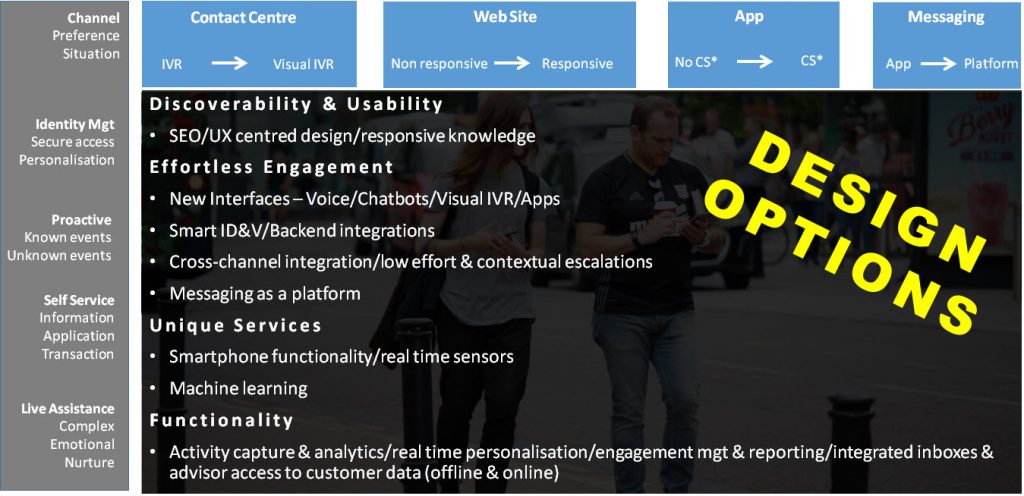
Why You Need A Mobile Customer Service Strategy
I currently begin my mobile customer service masterclass with a headline taken from the 2017 UK portion of Deloitte’s Global Mobile Survey
In less than a decade since it was first brought to market, smartphone use has blown up in the UK. More than four in five consumers own a smartphone and collectively check them a billion times a day.
To my mind, this is a major hint that the way customer service is delivered needs to evolve. Yet how many conferences, books or, more to point, service strategies really major on this obvious change in customer behaviour and engagement opportunity?
For instance, when asked, very few customer service leaders know the proportion of customers who use smartphones to engage with their customer service proposition. Yet it’s a key baseline question. How it has grown to date? What will it be in three years?
Does that matter? Absolutely! Here is one example why.
While you could simply replicate landline behaviours for an IVR interaction, (listen and punch in choices on a dial pad), smartphones offer a far more compelling user engagement option. Visual IVR is a revelation. It’s easy, option rich and conducive to self service. Even better it provides a bridge for customers to pivot between voice and online assets – a perfect bundle of functionality to encourage digital habits.
Here is one more.
The title of this post highlights another recent mobile behaviour. Messaging has quickly morphed into a global phenomena, often at the centre of how whole societies are progressing their digital agenda. Think Wechat in China. It’s already way beyond an app. It’s now more than a platform. At the very least it can be described as an ecosystem that supports millions of brands and customers to do pretty much everything we used to do on the open internet. And as a result of owning the entire experience, from engagement, to commerce to payments, Tencent and Alibaba now find themselves positioned to disrupt the financial service industry.
This might seem far removed from your own contact centre and what matters to you.
But it is not irrelevant. Nor is it something we can afford to ignore. China, India, Brazil, Africa are all in the process of leapfrogging western best practice in customer engagement as a result. Soon we shall be learning from them given their much more impressive velocity and speed of adoption.
That’s a big picture view. Even back down at ground level, messaging is still newsworthy. The killer features are that it’s real time while offering lapsed conversations over time (asynchronous) for those too time challenged to complete a conversatio. Messaging evangelists claim that each feature effectively trump email and chat.
Will either disappear as a result? Omni-channel history suggests not. Channels multiple, seldom die. But messaging’s unique ability to drag things into a real time context certainly redraws customer service baselines. And as and when messaging hits volumes currently soaked up by voice calls, it will be interesting to see how the real time feel can be preserved. Maybe queuing can be minimised with intelligent real time triaging or will conversational self service will come to the rescue in time and reduce demand for live assistance?
The key point though is that it is all taking place in the context of mobile devices. Even if we ignore the functional innovation that visual IVR and messaging brings, smartphone customer service is a distinct challenge and opportunity. The reduced size of screen, the array of embedded sensors offering unique functionality, the ‘make it simple, make it now’ mindset that smartphone use cultivates. All set a high bar on both the ux (user experience) and journey experience which brands have to get right.
And finally lets not ignore the advantage smartphone customers have over the vast majority of customer service operations. Access to voice, text and video are all readily available apps. In some cases, they are present within the same app or workspace. Of course this sets of the expectation that brands are able to match the same level of omni-channel fluidity which we all know remains a major current challenge.
What Goes Into The Pot
Hopefully I’ve made the case for rolling out the flipchart and figuring out what your mobile customer service strategy should be. If not then I’m not sure the rest of this post is going to be that interesting for you. But if you are convinced, then take a good look at the image at the top of this post. It is the framework we use in the masterclass to design a mobile customer service strategy.
Across the top are the possible channels of engagement your customers want you to provide. Albeit this time in a mobile context. The key challenge and
We’ve seen websites adding chat widgets in the past decade or so. These enable site visitors to strike up a conversation with the website owners. In many cases, companies use chat widgets for support and sales purposes. Companies have improved chat widgets over time, enabling more intelligent interactions through machine learning, images, and rich links, as well as the integration of voice and video calling through WebRTC or callback systems.
There’s a trend taking over chat widgets that also involves marketing automation, segmenting website visitors, and launching a conversation proactively through the use of automation rules. These shifts edge the channel from support and sales toward marketing and sale
Messaging
While SMS is a ubiquitous channel, it might not be the preferred choice. SMS can be expensive and limited. You can only use 160 characters per message and nothing but text.
According to WhatsApp, the platform saw 75 billion messages being shared on New Year’s Eve 2018, and these included over 13 billion images and 5 billion videos. Steady state WhatsApp has over 1.3 billion monthly active users. Less than a year after recruiting product managers for the explicit purpose of monetization,
WhatsApp has now officially launched WhatsApp Business.
The new app is catered to businesses looking to deliver customer service, and will feature business profiles and Confirmed Accounts so that consumers know they’re interacting with legitimate businesses. There are a few functions that are specifically designed for companies, including quick replies and greeting messages, as well as statistics and analytics so businesses can determine if they’re connecting with their customers properly (and if their messages are being read).
The free Android-only app allows businesses to create a profile with their information, send automatic replies to common questions and collects message statistics like the number of messages that are being successfully delivered and read.
Users will still retain the ability to block numbers, including any businesses that might be sending an excessive number of unwanted messages. The app is launching today on Android only initially, starting in Indonesia, Italy, Mexico, the U.K., and the U.S. More countries will get the app in the weeks ahead. WhatsApp is overwhelmingly popular in emerging markets, serving as an SMS replacement in regions where low-cost Android phones dominate. In other words India and Brazil are due to become huge markets.
Ultimately, Facebook-owned Whatsapp wants large enterprises like banks, airlines and e-commerce platforms to use the app “to provide customers with useful notifications like flight times, delivery confirmations, and other updates,” according to a September 2017 Whatsapp blog post announcing plans for the Whatsapp Business app
Mobile vendors
And then there’s Apple and Google.
While Google’s current offerings in this domain are slim, Apple offers a more compelling story. At WWDC 2017, Apple shared a developer preview of a new service called Apple Business Chat. This service enables easy discoverability of businesses that register with the service. It also offers the means for customers to communicate with these businesses directly via iMessage.
This approach makes messaging and interacting with businesses an integral part of the user experience of any iOS device.
Chatbots
What do Facebook Messenger, Line, WeChat, Skype, Telegram, Viber, Kik, Cisco Spark, and Slack have in common? They are all messaging platforms that now offer APIs for the creation of chatbots. And these APIs are designed and built to enable businesses to reach out to their customers on their messaging platform or social network of choice.
There’s a win-win-win situation here:
- Messaging platform vendors want these interactions to happen through their platform. Consumers already use messaging platforms for a large portion of their communications, so relying on them for communication with a business feels more natural.
- Businesses want to be where their customers are, and these messaging platforms make that more possible than ever.
- These types of interactions are bound to take place more on social networks and messaging applications. Such platforms already have over 3 billion users
It seems like publications and business owners everywhere are talking about the rise of chatbots. Businesses are supposed to deploy chatbots, consumer gadgets are implementing intelligent systems, and some even say our jobs will be displaced by bots in the future. Whether driven by humans or bots, many of our interactions with contact centers today and in the future will shift from phone calls to online rich-text chat sessions. The real question is, where will these conversations take place?
An omnichannel approach is based on the notion that customers want to interact with businesses on multiple different platforms. Some might prefer phone calls, others could be more inclined to chat online, and some might even use email. A more encompassing notion tries to look at a single interaction as taking place in multiple channels at once. In this scenario, a potential customer could find what they are looking for on a business’ website, initiate an interaction over a chat widget, and close the purchase through a phone call.
The omnichannel world
Moving to omnichannel means more than just more (or all) channels. It means striking a conversation with a customer on their preferred channel. Here are a few of the text-based channels currently available.
SMS and A2P
The most obvious of text channels is SMS. In the business context, it is also known as A2P SMS, or “application to person SMS,” where a contact center sends an SMS message to a customer notifying them of a sale or the status of their recent call.
While SMS is a ubiquitous channel, it might not be the preferred choice. SMS can be expensive and limited. You can only use 160 characters per message and nothing but text. While it provides a feeling of continuity in an ongoing conversation, there’s less ability for branding. There are other noteworthy messaging mediums today that are useful and needed.
Chat widgets and mobile applications
We’ve seen websites adding chat widgets in the past decade or so. These enable site visitors to strike up a conversation with the website owners. In many cases, companies use chat widgets for support and sales purposes. Companies have improved chat widgets over time, enabling more intelligent interactions through machine learning, images, and rich links, as well as the integration of voice and video calling through WebRTC or callback systems.
There’s a trend taking over chat widgets that also involves marketing automation, segmenting website visitors, and launching a conversation proactively through the use of automation rules. These shifts edge the channel from support and sales toward marketing and sales.
Some companies have taken this a step further by enabling direct chat interactions with their businesses through self-service applications. The communication process is similar to a chatbot on a website. In the case of a website, companies can also add voice and video calling options on top of rich text messages.
Business APIs
What do Facebook Messenger, Line, WeChat, Skype, Telegram, Viber, Kik, Cisco Spark, and Slack have in common? They are all messaging platforms that now offer APIs for the creation of chatbots. And these APIs are designed and built to enable businesses to reach out to their customers on their messaging platform or social network of choice.
There’s a win-win-win situation here:
- Messaging platform vendors want these interactions to happen through their platform. Consumers already use messaging platforms for a large portion of their communications, so relying on them for communication with a business feels more natural.
- Businesses want to be where their customers are, and these messaging platforms make that more possible than ever.
- These types of interactions are bound to take place more on social networks and messaging applications. Such platforms already have over 3 billion users.
Mobile vendors
And then there’s Apple and Google.
While Google’s current offerings in this domain are slim, Apple offers a more compelling story. At WWDC 2017, Apple shared a developer preview of a new service called Apple Business Chat. This service enables easy discoverability of businesses that register with the service. It also offers the means for customers to communicate with these businesses directly via iMessage.
This approach makes messaging and interacting with businesses an integral part of the user experience of any iOS device.
How do we get there?
There are so many channels these days, and growth doesn’t seem to be slowing down. We have to interact with customers where they are: on the phone, on our branded websites, in our own apps, on social networks, and over every conceivable medium.
Each of these channels has its own integration interface and its own APIs which companies need to use. Some of these channels are simple, and some are more complicated to connect and implement.
When businesses undertake the process of going omnichannel, there are three main approaches they can take.
Integration Options
Self development
A business, especially a developer-savvy one, can cobble together its own omnichannel solution.
There’s a challenge in maintaining the pace with supporting these channels. With each new channel, there are two additional activities that companies must take on. These include:
- Integrating with the specific API of that channel. This may also need to go through product management or legal to get access to the API and follow its restrictions.
- Maintaining that code. This is especially important when a service deprecates or updates its APIs.
Self-development is a great option if your team can maintain the resources necessary for updating the current codebase, as well as adding more channels when needed.
Employing CPaaS
Another alternative in creating an omnichannel communication platform is to use communication platform as a service, also known as CPaaS.
Up until recently, these platforms were mostly focused on SMS, voice, and video calling. Some offered IP messaging as well. One of the top trends in CPaaS is support for omnichannel. Nexmo, for example, offers a chat app service.
Twilio recently introduced a new concept called the Engagement Cloud. This solution takes the contact center building blocks to the next level by offering an omnichannel experience to their higher level APIs — what they call Declarative APIs. While classic CPaaS APIs focus on instructing the platform to take a very specific action, a declarative API defines the desired outcome and lets the CPaaS platform choose the optimal way to achieve that outcome. In this case, you don’t choose to send an SMS to a person, you notify them on the channel that best fits the situation at hand.
Then there are services such as Gupshup, which offers “omnichannel APIs for SMS, Voice, and IP Messaging” as well as a bot builder.
As more social networks and messaging platforms start opening up their APIs, the complexity of self-development will grow, which in turn will encourage more CPaaS vendors to offer these omnichannel APIs that companies can use for faster integration.
Using a readymade service
The most common alternative will likely be a readymade service. This is contact center software you can just onboard and use. The challenge here is that most contact center software doesn’t connect to messaging platforms directly. Such a service will probably first appear as an integration API and only later become a part of the platform’s offering.
Where do we go from here?
Messaging and chatbots are part of the modern contact center. They handle everything from fielding and deflecting customer issues to initiating conversations proactively with prospects at the right point in time.
When adding a messaging medium to your contact center, think about offering it in a multichannel environment — one that allows for the number of channels to continue to grow.
Discoverability & Usability
- SEO/UX centred design/responsive knowledge
Effortless Engagement
- New Interfaces – Voice/Chatbots/Visual IVR/Apps
- Smart ID&V/Backend integration
- Cross-channel integration/low effort & contextual escalations
- Messaging as a platform
Unique Services
- Smartphone functionality/real time sensors
- Machine learning
Functionality
- Activity capture & analytics/real time personalisation/engagement mgt & reporting/integrated inboxes & advisor access to customer data (offline & online)




